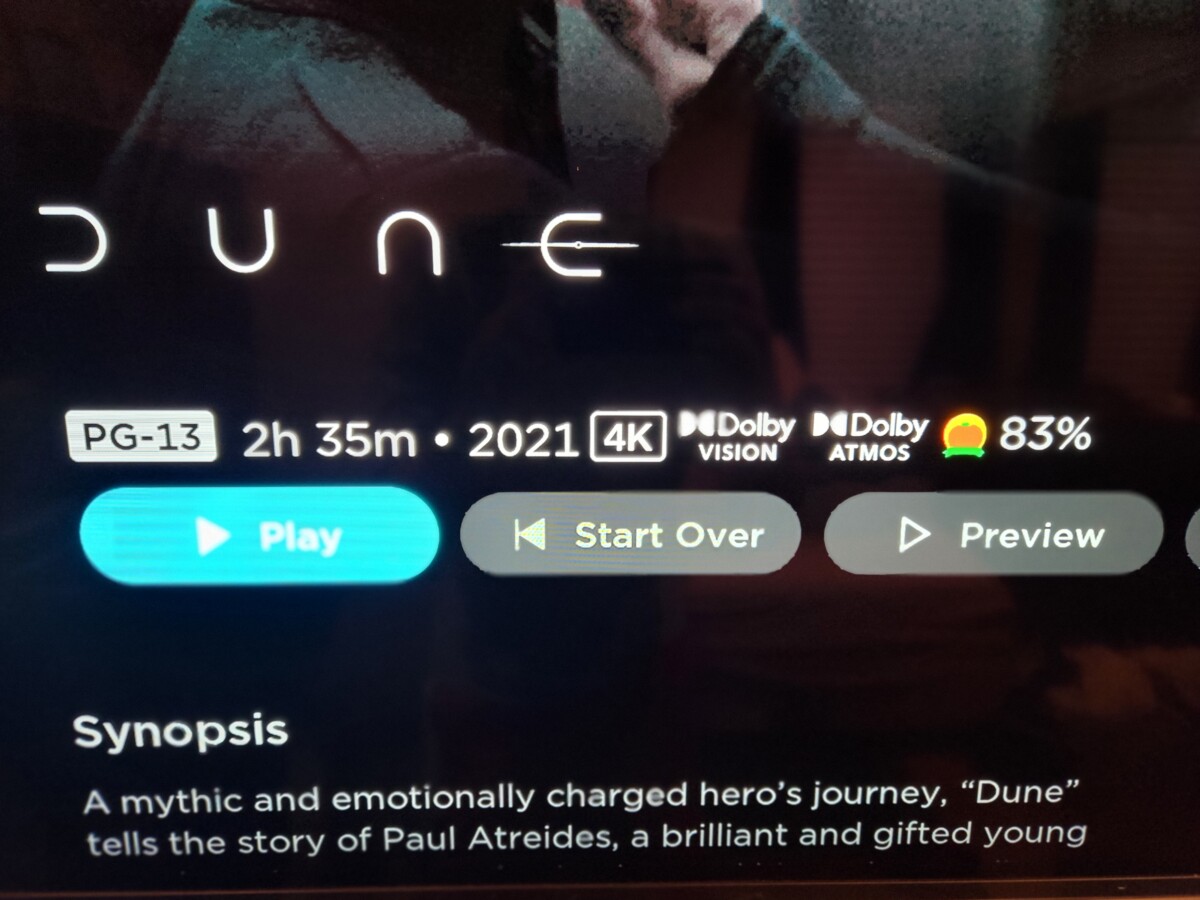As an Amazon Associate I earn from qualifying purchases
Many people are curious about Dolby’s HDR format as it is the second most popular on the market after HDR 10.
Dolby is well known within the Home Theater space thanks to their superb audio format Dolby Atmos but does Dolby Vision meet the same standard for picture quality?
Is there that big of a difference between Dolby Vision and HDR 10?
Dare I say it, is Dolby Vision a Gimmick?
Dolby Vision is not a gimmick but it is extremely overrated and does not exhibit much of a difference in comparison to something like HDR 10.
Many of the perks of Dolby Vision cannot be displayed on modern televisions and thus could be considered a marketing gimmick.
However, it’s still a very good HDR format, but it is overhyped.
In this blog post, I will explore the theoretical perks of Dolby Vision as well as its real-world application. I will also compare it to its competitor HDR 10.
The supposed perks of Dolby Vision
What sets Dolby Vision apart is its use of dynamic metadata instead of static metadata. Each scene displayed using Dolby Vision calls for its own unique use of HDR metadata.
For example, each frame is given its own instructions on how to be displayed with Dolby Vision, meanwhile, HDR 10 uses a very broad approach for an entire show or movie.
Tone mapping and brightness are set for the entire film for HDR 10 with Dolby Vision they are changed every frame, and this is the real benefit of DV.
However, many TV manufacturers disregard Dolby Vision’s metadata and use their own tone mapping, so it depends on your TV if you are getting the biggest perk of Dolby Vision.
12-bit color and 10,000 nits brightness
Dolby Vision can use 12-bit color so you get a wider color gamut compared to HDR 10 which has 10-bit color.
This results in getting access to almost 69 billion colors compared to HDR 10’s 1 billion.
This sounds great but it’s not entirely true. There is no 12-bit media available at this point so in a sense this marketing tactic is kind of a gimmick.
Also even if a display could show 69 billion colors the human eye can only see so much detail, its diminishing returns.
However, it is true that you get better black levels and brighter whites using DV.
Dolby Vision also says it can display 10,000 nits peak brightness, however, there is no modern television that can support that brightness level.
However, the true benefit of Dolby Vision is dynamic metadata which allows the TV to control brightness and color for each individual frame of the movie you are watching. Although I did mention previously that
Dolby Vision IQ
Another highly touted perk of Dolby Vision is Dolby Vision IQ, which is a property technology they recently launched.
Because so many viewers place their TVs in suboptimal places with excessive exposure to ambient light the perfect black levels of Dolby Vision are muted which can cause annoyance.
To combat this Dolby Vision came up with Dolby Vision IQ, which attempts to optimize the content you are watching based on the brightness of your room.
Unfortunately, major TV providers have not jumped on this bandwagon and big brands like Samsung and Sony have not adopted Dolby Vision IQ.
In theory, this sounds like a good feature but again it’s not widely available and a better alternative is to just control the amount of light in your room, a topic I’ve explored in several other posts on this site.
Movie Theaters are pitch black for a reason. Likewise, with TV you want to watch it in a dark room.
Honest personal opinion about Dolby Vision: Can you even tell the difference?
Personally, I cannot tell the difference between Dolby Vision and HDR 10. It is splitting hairs and even looking at the same image side by side (one in DV and one in HDR 10) the difference is extremely marginal.
I think as technology advances Dolby Vision can really separate itself from HDR 10 but its not at that point.
I would include screenshots of frames from my TV comparing DV and HDR 10 but id rather you watch a video instead for you to see the difference.
Here is a good one.
Reasons to avoid Dolby Vision
The primary reasons for avoiding Dolby Vision include it being more expensive and much less widely available. Both issues I will discuss more in-depth below.
You need the compatible equipment.
In order to play Dolby Vision you need a compatible TV and media source. Personally, I have a TV compatible with Dolby Vision (paid link), as well as a Blu-Ray Player.
I also buy 4k Blu-rays that have Dolby Vision although most of my 4K Blu Rays are HDR 10.
This can cost you thousands and thousands of dollars. Dolby Vision TVs are typically more expensive to offset the fee TV providers have to pay.
However, I will say that pretty much all high-quality TVs have Dolby Vision.
To be honest, if the TV does not have Dolby Vision HDR then that signals to me that something is wrong.
It’s standard for all modern TVs. I recommend TV’s all the time that have DV on this website but it’s not for the reason that they have that technology.
For example, one of the TVs I recommend all the time on this website is the TCL Q6.
It has Dolby Vision but I mostly recommend it for its other features like its QLED technology.
- 55 INCH 4K TV: Enjoy enhanced contrast, accurate colors, and fine details with our TCL 55-Inch Q6 QLED 4K Smart TV; Engineered with HDR PRO+ technology, including Dolby Vision, HDR10, HDR10+, and HLG for a breathtaking, vibrant picture quality
- QLED - QUANTUM DOT TECHNOLOGY: With over a billion colors, this 55 inch QLED TV showcases Quantum Dot Technology with UltraWide Color Gamut; With a HighBright Direct LED Backlight, our TCL QLED TVs produce brighter images for an enhanced viewing experience
- GOOGLE TV ENABLED: Experience UHD entertainment with Google Chromecast on this 55 inch smart tv; With the ability to cast directly from a mobile device, it offers a range of streaming services, bringing your favorite movies, shows, and live shows together
- MOTION RATE 240 AND MEMC FRAME INSERTION: Combining multiple motion enhancement technologies, this 4K UHD TV handles fast-paced scenes with ease; Breathing life into every image, our TCL 55 Inch TV ensures exceptional motion clarity
- GAME ACCELERATOR 120: Equipped with our Game Accelerator 120, this 120Hz TV provides a more responsive gameplay without lag; Also boasting a variable refresh rate powered by AMD FreeSync, this gaming TV is designed to keep you at the top of any leaderboard
However, you are paying for all of these things but very little content out there is Dolby Vision and the difference is marginal at best. I will discuss this problem more below.
It’s more exclusive
Dolby requires TV manufacturers to pay a licensing fee if they want to sell products using Dolby Vision.
Because of this Dolby Vision is a much more rare technology in comparison to HDR 10, which does not require manufacturers pay a fee.
Also, pretty much any 4k TV will support HDR 10, this is not the same with Dolby Vision. Content is more likely to be HDR 10 than Dolby Vision because of this.
I actually wrote a separate article where I briefly discuss why the overwhelming amount of 4k Blu-rays are HDR 10, not Dolby Vision.




99% in agreement, and I really appreciate it when folks in the AV equipment biz tell consumers what they need to hear. Who knows where the future will go with HDR, but it won’t be anytime soon when DV matters. Actually I had the chance to do a side-by-side blind test comparison recently between DV and HDR 10+ (which we find on Samsung TVs). It was quite fun and revealing. Out of 20 images, I judged 12 of them to be equal/identical. On the other 8, the differences were marginal, certainly nowhere near significant enough to inform a choice of which TV to buy, but on 4 of these 8, I preferred the HDR10+ image to the DV image. Moreover, there’s no way to generalize across the example set, so it’s not just a marginal difference, it’s also an arbitrary one.
That brings up the 1% disagreement, though I’m sure you know this already. Samsung doesn’t use DV, at least not officially. Sure, that may change at some point, but it qualifies your claim that there’s something wrong with a high-end TV if it doesn’t support DV. All things being equal, I’d choose a Samsung QD-OLED over comparable screens from LG or Sony any day, not to mention the fact that the deals we’re seeing now on 2023 Samsungs are quite insane. Best example: You can get a 77 inch S89c at Best Buy for $1800 (the price fluctuates but it’ll keep returning to this price point until they’re gone). It’s essentially the same TV – and panel, contrary to some false reports that have hung around – as the S90c. This Samsung doesn’t support DV but its picture quality is significantly superior to the LG C3, for example, which does support DV but costs around $400 more. Not that I’m advocating “brand loyalty” or whatever. I advise folks to ignore brands and gimmicky features completely and just focus on the value proposition based on the core tech that you’re buying. When you buy a TV, ie at what point in the yearly cycle (eg Black Friday or March-ish when the new models start showing up), will determine to a greater extent the picture quality you can afford than any brand name or sexy new feature.
Bottom line, TVs are amazing now, so if you get a mid- or high-end TV from one of the main manufacturers, it’s gonna be awesome regardless of the gimmicky details, as you aptly put it.
One last note. I’d make a stronger argument for the relevance of Dolby Atmos and DTSx and audio in general as compared to versions of HDR. I know these can be just as gimmicky, and maybe most people don’t know or care about spatial surround, but especially for folks who still like their old-school blurays and are willing to pay for a decent home theater system, I find, when tracks are mixed well, they can produce some amazing experiences, not just with movies but music too. And the audio part is 50% of the TV experience, so it’s worth thinking about when evaluating priorities.
Yeah I think your right about the correlation part. Dolby Vision TVs are often better than non DV but that has nothing to do with DV it just to happens that TV’s with dolby vision have better components. Its the same with 4k blu ray, dolby atmos is almost excvlsive to that format. If they wanted to they could have standard blu ray discs with atmos but they choose not to. Dolby Vision is way overhyped and I question anyone who claims they can tell a difference, its splitting hairs.